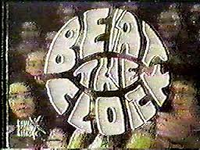No edit summary |
m (→Hosts) |
||
| Line 11: | Line 11: | ||
Jack Narz (1969-1972)<br /> |
Jack Narz (1969-1972)<br /> |
||
Gene Wood (1972-1974) |
Gene Wood (1972-1974) |
||
| + | |||
| + | ==Announcers== |
||
| + | Gene Wood (1969-1972)<br /> |
||
| + | Nick Holenreich (1972-1974) |
||
==Gameplay== |
==Gameplay== |
||
Revision as of 16:17, 22 January 2014
Beat the Clock was a stunt-based game show where couples completed stunts (along with a celebrity aide) for cash. based on the American game show of the same name.
Broadcast
CTV 1970-1974
Packager
Mark Goodson/Bill Todman Productions
Hosts
Jack Narz (1969-1972)
Gene Wood (1972-1974)
Announcers
Gene Wood (1969-1972)
Nick Holenreich (1972-1974)
Gameplay
Narz era
In early episodes, couples now aided a weekly celebrity guest played for points simply by completing stunts. The first couple to reach 100 points won a prize package. This was subsequently changed to couples receiving a prize every time they won, which was later replaced by the winning couple facing a "cash board" with "BEAT THE CLOCK" spelled out on three levels, each letter concealing a money amount either $25 (4), $50 (5), $100 (2) or $200. The couple would agree on a letter, select it and the winnings would be revealed.
In addition, if a couple completed a stunt in less than half the time, the remaining time would be used for awarding a cash bonus. Anywhere from $10 to $50 would be awarded for each time the stunt could be completed in the time remaining.
At some point during the show, the celebrity would perform a "Solo Stunt" (which seemed to have supplanted the Bonus Stunt on the original show). The couple could win $50 if they guessed correctly whether the star could "beat the clock" or vice versa. Towards the end of Narz's tenure as host, stunts would be replaced in the 2nd half of the show with the celebrity playing a game of intuition with the couples who would play for a cash prize that was divided among them.
During this time, the show was syndicated through 20th Century Fox Television. One of the unusual aspect of these shows was that Narz's suit jackets had a "Beat the Clock" logo sewn onto their pockets, somewhat similar to the scrambled Concentration logo found on emcee Hugh Down's blazer at the same time.
Wood era
Jack Narz left the show in 1972 at the time, he made no announcement and gave no reason for his departure. In a 2007 Internet radio interview, Narz finally explained that the show's budget did not include his personal travel expenses; Narz had to pay for his travels and the cost of airline fair between his Los Angeles home and Montreal became prohibitive. His travel costs were essentially equal to his earnings, and even a successful appeal to Mark Goodson for more money was not enough.
Announcer Gene Wood hosed the show for the next two seasons. Wood had also been hosting a similar stunt game titled Anything You Can Do, a battle-of-the-sexes competition which was also recorded in Canada. CFCF-TV Montreal staff announcer Nick Holenreich became the show's announcer; he had previously announced for a week during Narz's final season in which Wood was the celebrity guest. At this time, the show also changed syndicators to Firestone syndication Services, which syndicated another Goodson-Todman show, To Tell the Truth, which also has originally been hosted by Bud Collyer.
The show was now called The New Beat the Clock (although the logo still read simply Beat the Clock) and the set was refreshed with a new color scheme and a redesigned clock. like its predecessor, Wood also wore suit jackets with the show's logo sewn on the pockets.
The only change in the format were that the couples were introduced separately and played two stunts, win or lose (a win still getting a trip to the cash board) and both couples competed simultaneously in a final stunt with the winning couple receiving a prize. Celebrity guests were retained in the new format (once again aiding the contestants) and performing the solo stunt as well as "co-judge" with Wood in the final stunt of the day. Another throwback to the Collyer era (when the show was seen in the daytime) was the revival of "Ladies' Day" where women only (not counting the celebrity for that week) would play the game.
Despite continued popularity on local stations in both daytime and prime time access timeslots, Goodson-Todman decided to discontinue production of Clock in 1974 when CTV asked the company for half of the proceeds from advertisers awarding their wares as contestant consolation prizes. Wood returned to voice-over work and went on to a 20-year career announcing Los Angeles-based shows for Goodson-Todman and occasionally other packagers. However, he never hosted another show.
Trivia
- For the first three seasons (1969-1970), the show was taped at The Little Theatre on Broadway in New York City. After that, taping moved to Montreal, Quebec as a cost-saving measure. This was the only time Goodson-Todman taped a series in Canada that was not for a Canadian-specific audience.
- The music for this version of Clock was played live on the organ by the renowned keyboardist and arranger Dick Hyman.

